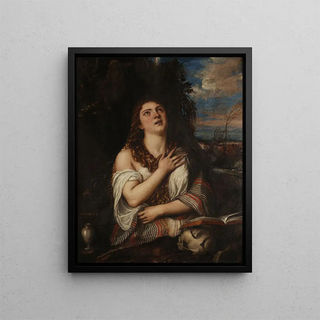Art print | Madeleine pénitente - Titien


View from behind

Frame (optional)
The "Penitent Magdalene" by Titian is a masterpiece that transcends time and eras, inviting viewers to immerse themselves in a universe of spirituality and contemplation. This painting, embodying the beauty and complexity of the human soul, depicts Mary Magdalene in a moment of deep reflection and repentance. The figure's posture, delicate gestures, and expression filled with melancholy capture the very essence of penitence. Gazing upon this artwork, one is transported into an intimate dialogue between faith and human fragility, revealing the depth of emotions that art can evoke.
Style and uniqueness of the artwork
Titian's style in this piece is a harmonious blend of realism and sensuality. The rich, nuanced color palette lends the scene an atmosphere of warmth and depth. The interplay of light and shadow, characteristic of his approach, highlights the delicate features of Mary Magdalene, emphasizing her expression of sadness and redemption. Titian excels in depicting textures, whether the softness of skin or the fluidity of drapery, creating an illusion of life that captivates the eye and the mind. This painting does not merely portray a religious figure; it evokes an emotional experience, a spiritual quest that resonates deeply with the viewer.
The artist and his influence
Titian, master of the Venetian Renaissance, left a significant mark on his era through his boldness and innovation. Trained in the workshops of the greatest artists of his time, he quickly developed a personal style that combines tradition with a visionary approach. His influence extends far beyond his lifetime, inspiring generations of artists across Europe. The "Penitent Magdalene" demonstrates his ability to fuse religious representation with a humanist approach, centered on the individual. By exploring themes of redemption and human suffering, Titian paved the way for a new understanding of sacred art, transforming how religious figures were perceived and depicted.
An exceptional wall decoration signed Artem Legrand
In the context of a decoration

Matte finish

View from behind

Frame (optional)
The "Penitent Magdalene" by Titian is a masterpiece that transcends time and eras, inviting viewers to immerse themselves in a universe of spirituality and contemplation. This painting, embodying the beauty and complexity of the human soul, depicts Mary Magdalene in a moment of deep reflection and repentance. The figure's posture, delicate gestures, and expression filled with melancholy capture the very essence of penitence. Gazing upon this artwork, one is transported into an intimate dialogue between faith and human fragility, revealing the depth of emotions that art can evoke.
Style and uniqueness of the artwork
Titian's style in this piece is a harmonious blend of realism and sensuality. The rich, nuanced color palette lends the scene an atmosphere of warmth and depth. The interplay of light and shadow, characteristic of his approach, highlights the delicate features of Mary Magdalene, emphasizing her expression of sadness and redemption. Titian excels in depicting textures, whether the softness of skin or the fluidity of drapery, creating an illusion of life that captivates the eye and the mind. This painting does not merely portray a religious figure; it evokes an emotional experience, a spiritual quest that resonates deeply with the viewer.
The artist and his influence
Titian, master of the Venetian Renaissance, left a significant mark on his era through his boldness and innovation. Trained in the workshops of the greatest artists of his time, he quickly developed a personal style that combines tradition with a visionary approach. His influence extends far beyond his lifetime, inspiring generations of artists across Europe. The "Penitent Magdalene" demonstrates his ability to fuse religious representation with a humanist approach, centered on the individual. By exploring themes of redemption and human suffering, Titian paved the way for a new understanding of sacred art, transforming how religious figures were perceived and depicted.
An exceptional wall decoration signed Artem Legrand
In the context of a decoration






